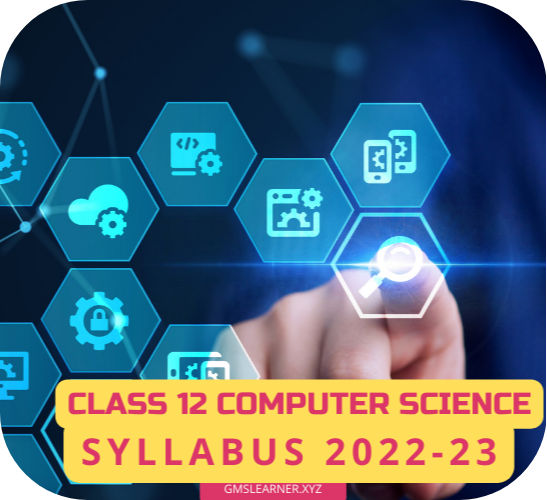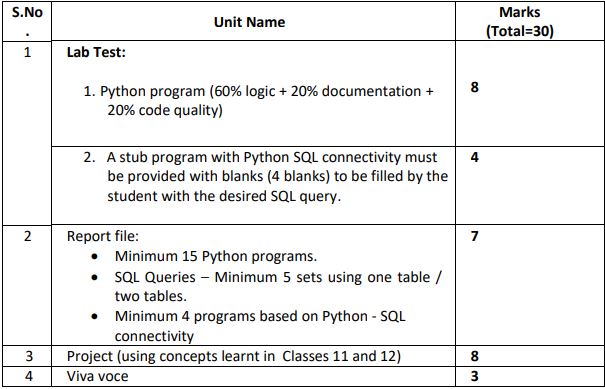Check CBSE Class 12 Computer Science Syllabus 2022-2023 to know the revised course content and examination scheme. Check and download the syllabus in PDF here.
 |
| CBSE Class 12 Computer Science Syllabus 2022-2023 |
CBSE Class 12 Computer Science Syllabus for the 2022-2023 session is provided below for students to download in PDF. This syllabus is important to know the course structure including weightage assigned to different units and examination scheme for theory and practicals. Students should prepare for their board exam according to the content mentioned in this revised syllabus only.
Check CBSE Class 12 Computer Science Syllabus 2022-23 below:
Computer Science CLASS-XII Code No. 083 2022-23
1. Prerequisites
Computer Science- Class XI
2. Learning Outcomes
Student should be able to
a) apply the concept of function.
b) explain and use the concept of file handling.
c) use basic data structure: Stacks
d) explain basics of computer networks.
e) use Database concepts, SQL along with connectivity between Python and SQL.
3. Distribution of Marks:
Also Read| CBSE Class 12 Revised Syllabus 2022-2023 (All Subjects)
4. Unit wise Syllabus
Unit I: Computational Thinking and Programming – 2 ·
- Revision of Python topics covered in Class XI. ·
- Functions: types of function (built-in functions, functions defined in module, user defined functions), creating user defined function, arguments and parameters, default parameters, positional parameters, function returning value(s), flow of execution, scope of a variable (global scope, local scope) ·
- Introduction to files, types of files (Text file, Binary file, CSV file), relative and absolute paths ·
- Text file: opening a text file, text file open modes (r, r+, w, w+, a, a+), closing a text file, opening a file using with clause, writing/appending data to a text file using write() and writelines(), reading from a text file using read(), readline() and readlines(), seek and tell methods, manipulation of data in a text file
- Binary file: basic operations on a binary file: open using file open modes (rb, rb+, wb, wb+, ab, ab+), close a binary file, import pickle module, dump() and load() method, read, write/create, search, append and update operations in a binary file ·
- CSV file: import csv module, open / close csv file, write into a csv file using csv.writer() and read from a csv file using csv.reader( ) ·
- Data Structure: Stack, operations on stack (push & pop), implementation of stack using list.
Unit II: Computer Networks
- Evolution of networking: introduction to computer networks, evolution of networking (ARPANET, NSFNET, INTERNET)
- Data communication terminologies: concept of communication, components of data communication (sender,receiver, message, communication media, protocols), measuring capacity of communication media (bandwidth, data transfer rate), IP address, switching techniques (Circuit switching, Packet switching)
- Transmission media: Wired communication media (Twisted pair cable, Co-axial cable, Fiber-optic cable), Wireless media (Radio waves, Micro waves, Infrared waves)
- Network devices (Modem, Ethernet card, RJ45, Repeater, Hub, Switch, Router, Gateway, WIFI card)
- Network topologies and Network types: types of networks (PAN, LAN, MAN, WAN), networking topologies (Bus, Star, Tree)
- Network protocol: HTTP, FTP, PPP, SMTP, TCP/IP, POP3, HTTPS, TELNET, VoIP
- Introduction to web services: WWW, Hyper Text Markup Language (HTML), Extensible Markup Language (XML), domain names, URL, website, web browser, web servers, web hosting
Unit III: Database Management ·
- Database concepts: introduction to database concepts and its need ·
- Relational data model: relation, attribute, tuple, domain, degree, cardinality, keys (candidate key, primary key, alternate key, foreign key) ·
- Structured Query Language: introduction, Data Definition Language and Data Manipulation Language, data type (char(n), varchar(n), int, float, date), constraints (not null, unique, primary key), create database, use database, show databases, drop database, show tables, create table, describe table, alter table (add and remove an attribute, add and remove primary key), drop table, insert, delete, select, operators (mathematical, relational and logical), aliasing, distinct clause, where clause, in, between, order by, meaning of null, is null, is not null, like, update command, delete command, aggregate functions (max, min, avg, sum, count), group by, having clause, joins: cartesian product on two tables, equi-join and natural join ·
- Interface of python with an SQL database: connecting SQL with Python, performing insert, update, delete queries using cursor, display data by using fetchone(), fetchall(), rowcount, creating database connectivity applications
5. Practical
6. Suggested Practical List:
Python Programming
- Read a text file line by line and display each word separated by a #.
- Read a text file and display the number of vowels/consonants/uppercase/lowercase characters in the file.
- Remove all the lines that contain the character 'a' in a file and write it to another file.
- Create a binary file with name and roll number. Search for a given roll number and display the name, if not found display appropriate message.
- Create a binary file with roll number, name and marks. Input a roll number and update the marks.
- Write a random number generator that generates random numbers between 1 and 6 (simulates a dice).
- Write a Python program to implement a stack using list.
- Create a CSV file by entering user-id and password, read and search the password for given user id.
Database Management
- Create a student table and insert data. Implement the following SQL commands on the student table: o ALTER table to add new attributes / modify data type / drop attribute o UPDATE table to modify data o ORDER By to display data in ascending / descending order o DELETE to remove tuple(s) o GROUP BY and find the min, max, sum, count and average
- Similar exercise may be framed for other cases.
- Integrate SQL with Python by importing suitable module.
7. Suggested Reading Material ·
NCERT Textbook for COMPUTER SCIENCE (Class XII) ·
Support Materials on the CBSE website.
8. Project
The aim of the class project is to create something that is tangible and useful using Python file handling/ Python-SQL connectivity. This should be done in groups of two to three students and should be started by students at least 6 months before the submission deadline. The aim here is to find a real world problem that is worthwhile to solve.
Students are encouraged to visit local businesses and ask them about the problems that they are facing. For example, if a business is finding it hard to create invoices for filing GST claims, then students can do a project that takes the raw data (list of transactions), groups the transactions by category, accounts for the GST tax rates, and creates invoices in the appropriate format. Students can be extremely creative here. They can use a wide variety of Python libraries to create user friendly applications such as games, software for their school, software for their disabled fellow students, and mobile applications, of course to do some of these projects, some additional learning is required; this should be encouraged. Students should know how to teach themselves.
The students should be sensitised to avoid plagiarism and violations of copyright issues while working on projects. Teachers should take necessary measures for this.
Students may also download the full syllabus in PDF from the following link:

